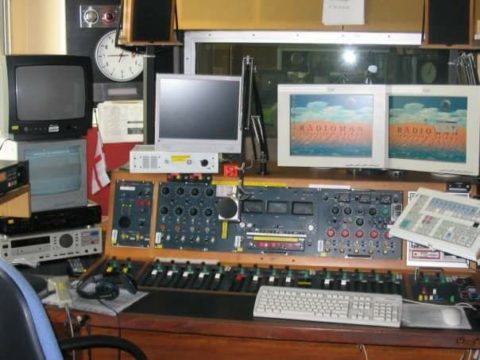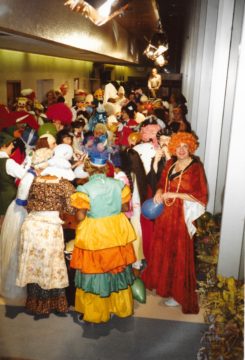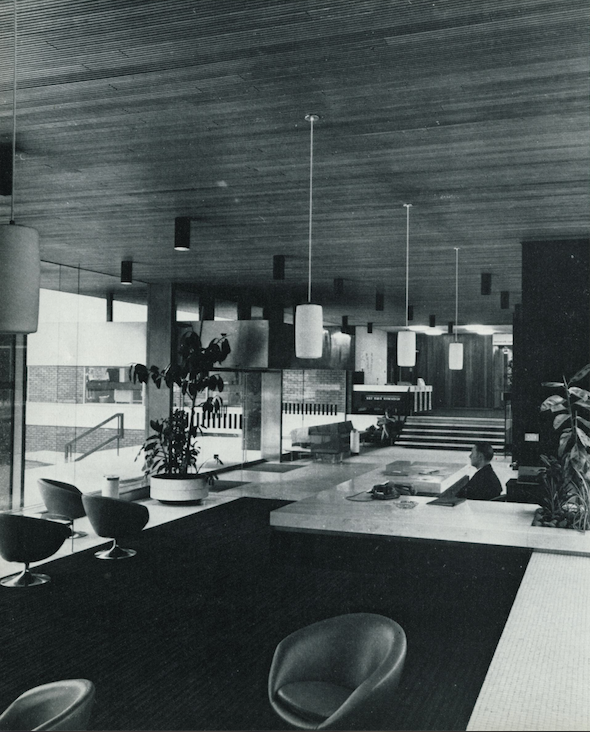
Photo from Rod Fawcett, no reproduction without permission
Chris Nelson in Radio WM, with the desk partially dismantled, on the first floor of Pebble Mill.
The following comments were added to the Pebble Mill Facebook page:
Andy Walters: ‘That’s gotta be Area 1. The only Studio that was orientated that way. The removed unit will contain the Peak Programme Meters, Red DTX buttons and Talkback as well as master level controls.’
Paul Hunt: ‘I think it’s a very young Chris Nelson and he’s sitting in Area 1. (In Area 2 and 4 the operator had their back to the window) The central module has been removed. It wasn’t uncommon for folk to hit the tannoy or DTX (Direct to transmitter) buttons so hard that they would stick in. These BBC Mark 3 desks were hand built by the equipment department at Avenue House in Chiswick. The last one in service is at Radio Lancashire, not bad considering they were designed in the 1970’s!!’
Andy Marriott: ‘Wow, is Lancashire really the last Mk3 site? Does that mean everyone else is ViLoR’ed now? Or are the post 2000 refurbed ER template sites still in service?
I’ve got one of those centre modules in my garage, ex-Humberside, I think. What I’d like to know is what are those 7 segment LED displays are? Next to the LS3/5. Didn’t WM have some kind of computer controlled CD jukebox system for their music?’
Andy Walters: ‘There was a CD jukebox controlled by Acorn RISC computers with NSM mechanisms. It was originally bought for CWR in Coventry. I remember chucking it in the skip. The hard disk system was called Numisys but I do think it was there for very long. World Service used Numisys a lot. The display by the speaker, I think were timers for the two Gram channels.’
Paul Hunt: ‘We did the trial with Studer Numisys in 1994. As Andy points out the CD jukebox system was moved over in 1996 after the merger with CWR.’
Philip Morgan: ‘Am I correct in thinking that this area was originally the Station Manager’s office (i.e. Jack Johnston’s) in the 1970’s? I believe these areas were originally designated something like studio’s 8, 9, and 10 when Pebble Mill was under construction and the area was reserved for the Midland Region of Radio 4.’
Rod Fawcett: ‘The cart machine on the right is a BE (Broadcast Electronics) triple deck – replaced eventually by the Sonifex Micro HS series… The photo is from the 80s and after Radio WM became stereo (as of course its a Mk III stereo console). I can’t remember when WM converted to stereo exactly, was it 1985??’
Simon Walsh: ‘This is the Late Nights with Adil Ray desk, and was a pleasure to drive.’
Thomas Graal: ‘It looks like Chris Nelson with hair to me. The LP on the desk is 20 Fabulous Hits by Jake Thackray originally released in 1975.’
Paul Hunt: ‘So who do I bump into in the basement of BH today but Chris Nelson. He loved the photo and said it was working with people like Ed Doolan that helped him get on. He now travels the globe directing multi camera programmes for BBC World.’
Andy Walters: ‘Here’s how the same studio looked on WMs last day in 2004. It was the last studio on air as it was used by the Asian Network for six weeks after WM left.’

Save
Save
Save
Save
Save
Save
Save





